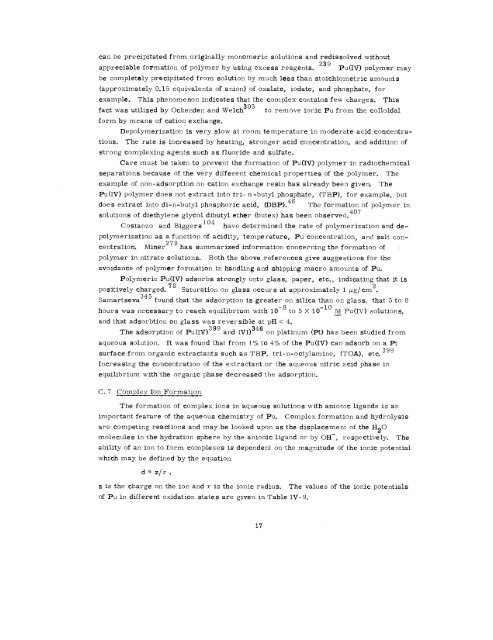THE RADIOCHEMISTRY OF PLUTONIUM - Sciencemadness.org
THE RADIOCHEMISTRY OF PLUTONIUM - Sciencemadness.org
THE RADIOCHEMISTRY OF PLUTONIUM - Sciencemadness.org
You also want an ePaper? Increase the reach of your titles
YUMPU automatically turns print PDFs into web optimized ePapers that Google loves.
can be precipitated from originally monomeric solutions and redis solved without<br />
appreciable formation of polymer by using excess reagents.<br />
239<br />
Pu(IV) polymer lmay<br />
be completely precipitated from solution by much less than stoichiometric amounts<br />
(approximately 0.15 equivalents of anion) of oxalate, iodate, and phosphate, for<br />
example. This phenomenon indicates that the complex contains few charges. This<br />
fact was utilized by Ockenden and Welch305 to remove ionic Pu from the colloidal<br />
form by means of cation exchange.<br />
Depolymerization is very slow at room temperature in moderate acid concentra-<br />
tions. The rate is increased by heating, stronger acid concentration, and addition of<br />
strong completing agents such as fluoride and sulfate.<br />
Care must be taken to prevent the formation of Pu(IV) polymer in radio chemical<br />
separations because of the very different chemical properties of the polymer. The<br />
example of non-adsorption on cation exchange resin has already been given The<br />
Pu(IV) polymer does not extract into tri- n -butyl phosphate, (TBP), for example, but<br />
does extract into di-n-butyl phosphoric acid, (DBP).46 The formation of polymer in<br />
solutions of diethylene glycol dibutyl ether (butex) has been observed.<br />
407<br />
Costanzo and Biggers<br />
104<br />
have determined the rate of polymerization and de-<br />
polymerization as a function of acidity, temperature, Pu concentration, and salt con-<br />
centration. Miner278 has summarized information concerning the formation of<br />
polymer in nitrate solutions. Both the above references give suggestions for the<br />
avoidance of polymer formation in handling and shipping macro amounts of Pu.<br />
Polymeric Pu(IV) adsorbs strongly onto glass, paper, etc., indicating that it is<br />
78<br />
positively charged. Saturation on glass occurs at approximately 1 ~g/ cm2.<br />
Samartseva345 found that the adsorption is greater on silica than on glass, that 5 to 8<br />
hours was necessary to reach equilibrium with 10-8 to 5 X 10-10 M Pu(lV) solutions,<br />
—<br />
and that adsorption on glass was reversible at pH < 4.<br />
The adsorption of Pu(IV) 399 and (VI)346 on platinum (Pt) has been studied from<br />
aqueous solution. It was found that from 17. to 4~0 of the Pu(IV) can adsorb on a Pt<br />
surface from <strong>org</strong>anic extractants such as TBP, tri-n-octylamine, (TOA), etc. 399<br />
Increasing the concentration of the extractant or the aqueous nitric acid phase in<br />
equilibrium with the <strong>org</strong>anic phase decreased the adsorption.<br />
C. 7 Complex Ion Formation<br />
The formation of complex ions in aqueous solutions with anionic ligands is an<br />
important feature of the aqueous chemistry of Pu. Complex formation and hydrolysis<br />
are competing reactions and may be looked upon as the displacement of the H20<br />
molecules in the hydration sphere by the anionic ligand or by OH-, respectively. The<br />
ability of an ion to form complexes is dependent on the magnitude of the ionic potential<br />
which may be defined by the equation<br />
d=zjr.<br />
z is the charge on the ion and r is the ionic radius. The values of the ionic potentials<br />
of Pu in different oxidation states are given in Table IV- 9.<br />
17
















